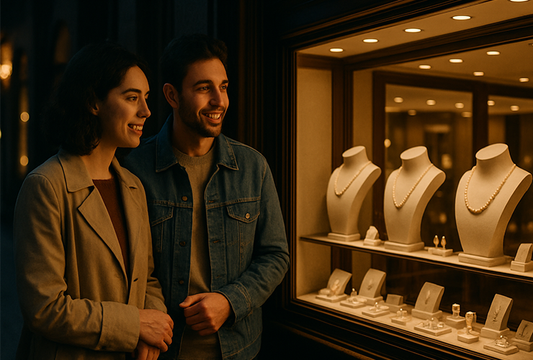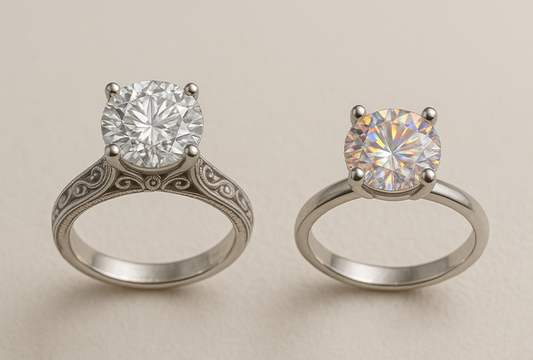Well, hello, glitter-chasers and love-struck proposers!
You're sailing the diamond seas, eh?
Then it’s time we talk GIA diamonds.
What’s GIA you ask? They’re only the valedictorian of the diamond world, a Harvard graduate among gems.
When a diamond decides to 'GIA,' it's promising to bare it all - the good, the bad, and the brilliant!
This GIA gal or guy will tell you about its journey, from when it was a glimmer in the earth's crust to when it became a sparkler on your finger.
It’s like your diamond sends you love letters stamped with the GIA seal of authenticity.
Intrigued?
Strap in because we’re about to take a joyride through the world of GIA certification.
Get ready to be dazzled!
In this article...
What is the GIA?
Ever wondered about the gatekeepers of glitter, the grandmasters of gleam, or the umpires of radiance?
Look no further, shiny-eyed dazzler because we're talking about the one, the only, the Gemological Institute of America, or the GIA, as they're fondly known.
The GIA is the veritable Hogwarts of the gem world.
Set up more than 85 years ago, this glittering institution is now the worldwide gold standard in evaluating diamond quality.
Headquartered in the bling capital of the world, Carlsbad, California, the GIA has offices sprinkled around the globe, with the goal that no diamond remains ungraded.
Ever heard of the "4Cs" of diamond quality? Of course, you have! But go on, have a guess who coined this term?
It was none other than the GIA back in the swingin' 1940s!
Just like red carpets are incomplete without celebrities, diamonds are incomplete without the GIA's endorsement.
What is a GIA certificate?
Now, let's dig into the crème de la crème, the Hollywood star on the Walk of Fame, the Instagram-verified badge of the gem world - the GIA certificate.
Imagine a diamond’s resumé with references, academic credentials, and special skills. That's the GIA certificate!
A GIA certificate is not just a document; it's a treasure map that details the uniqueness of your diamond.

A bit like a private detective, this certificate confirms the stone's authenticity and quality, ensuring you won't be bamboozled by a synthetic diamond posing as the real deal.
This certificate lays out the diamond's brilliance, cut, color, clarity, carat weight, and known treatments as clearly as the lyrics to your favorite tune.
They make everything super clear, so you know exactly what you're getting.
Like a backstage pass to a concert, a GIA certificate gives you an all-access, behind-the-scenes look at your diamond.
Does the GIA grade all diamonds?
Now, a burning question - are all diamonds graded by the GIA? The answer, our dear gem-seekers, is no.
Just as not all donuts are glazed with a delightful sugar coating, not all diamonds are assessed by the GIA.
Other gemological labs and grading institutes also sprinkle their expertise on diamonds.
However, getting your diamond graded by the GIA is like getting a thumbs-up from the Simon Cowell of the Gem world.
You can see the significance of this particular certification in our full guide on diamond certifications.
It’s a vote of confidence, a seal of authenticity that stands unchallenged in all things shiny.
Is it important to get a diamond GIA graded?
Let's begin our sparkling conversation with a thought. Imagine buying a mansion without knowing the square footage or a car without confirming the horsepower.
Similarly, when it comes to diamonds, the stakes are equally high, or dare we say, "high-carat." Enter stage-right: GIA grading.
The Gemological Institute of America (GIA) is the VIP bouncer of the diamond world - it sets the standard, it’s trustworthy, and without it, you're essentially gate-crashing the diamond party.
The GIA created a universal grading system in the 1940s and 50s, pioneering the 4Cs of Diamond Quality and the International Diamond Grading System™.
This gave us a common, consistent language for diamonds.

When your diamond is GIA graded, it's like having a verified profile on a social media platform.
It offers that sweet blue tick of assurance - an unbiased validation of your diamond's cut, color, clarity, carat weight, and more.
Thus, if you plan to buy a diamond, getting it GIA-graded is as crucial as a bowtie on a tuxedo.
It's all about the assurance and confidence it brings to your purchase.
Does a GIA grading affect the price of a diamond?
Ever wondered why certain blue jeans with a red tag cost more than others? It's all about brand reputation and trustworthiness.
Similarly, a GIA grading can indeed affect the price of your diamond.
Having your diamond GIA graded is like being handed the dictionary in a Spelling Bee - it gives you an edge.
A universally accepted authority gives your precious rock a universally accepted value.
This could mean a higher price point because when it comes to diamonds, information isn't just power; it's dollar signs too.
GIA grading doesn't just list the diamond's qualities; it also reveals if the diamond has been treated in any way to enhance its appearance.
This could influence how the diamond is valued, like revealing a magician's secrets.
A natural diamond with no enhancements but the same 4Cs could be valued higher than its treated counterpart.
And the gemologists at the GIA take diamond grading very seriously - they are stringent as can be.
A diamond with a GIA certificate has the highest seal of approval.
Like most things in life, grading a diamond is a subjective art, so the GIA has several of their pro gemologists check each stone before anointing it with its final grade.

The more eyes, the more accurate the grade!
Even if you have the best jeweler in the world (*cough* us *cough*) you have the extra reassurance from the GIA that your diamond is as real as can be.
In fact, you may find that a diamond may be sold at a higher grade than it is when ascertained from a jeweler or competing lab.
So, for instance, it may be graded as an F color but when it gets to the GIA, their precise reporting and thorough checks reveal its a G.
Don’t worry - the jeweler or competing lab isn’t trying to pull the wool (or diamonds!) over your eyes.
The GIA are expertly trained to spot what most can’t.
It’s why GIA diamonds will almost always come with a higher perceived price tag!
The real gold as to why this occurs is because the GIA is a non-profit organization meaning they have no financial interest in the graded outcome of your diamond.
They’re not selling diamonds or making profits from grading your diamond higher or lower.
All that matters to them is the quality of your gem and that it meets their world renowned standards.
So, yes, there is a small chance you may purchase a higher quality diamond than graded by an independent jeweler or competing lab, you may also lose out on your diamond's true value were you to ever sell it or trade it in against a new piece.
While diamonds are forever, the GIA grading makes this forever a little shinier, sparklier, and possibly a bit pricier too.
Ultimately, if you’re spending your hard earned cash on a beautiful diamond, you want to know everything about it and confirm it’s the real deal.
Either choosing a pre-graded GIA diamond or appointing the GIA to grade your diamond after purchase will give you the peace of mind you’re looking for.
But remember, a diamond without a GIA grading isn't any less of a diamond - it just means it's waiting to have its story told by the diamond storytellers themselves, the GIA.
How does GIA grading work?
Almost like a Michelin Star to a restaurant, a grade from the Gemological Institute of America (GIA) is like a royal seal of approval for a gem.
Picture a diamond on a tiny throne, scepter in hand!
That’s an adorable image for some reason - anyway, let's back to reality.
So, how does GIA grading work?
First, let's get up close and personal with your stone.
Several highly trained gemologists take your gem on a lovely date under a microscope.
They evaluate its color, clarity, cut, and carat weight—often called the 4Cs.

credit: Gemological Institute of America
Imagine it like a blind date, but rather than wondering if your date has a good sense of humor, you're looking at your stone's inclusions, blemishes, and the precise geometry of its cut.
The stakes are high!
Next, these features are scrupulously documented. Just like a meticulous diary entry, the gemologists jot down every little detail right down to any hidden beauty spots!
After a deep, comprehensive analysis, the gemologist, feeling like they've known your gem for a lifetime, assigns it a final grade.
According to the GIA themselves, they are so scrupulous with this process to ensure every diamond meets the 4Cs of Diamond Quality and the International Diamond Grading System.
They’re all about trust and will only print a GIA certificate when they have ensured accuracy, objectivity, and integrity at each stage of grading.
They also examined your diamonds anonymously so they can guarantee an accurate grade without being influenced by the other gemologists’ reports!
Does the GIA-grade lab-grown diamonds?
Plot twist in the jewelry world, folks! Yes, the grand old GIA has recently started to grade lab-grown diamonds.
It's like the stalwart classic car aficionado who suddenly takes a shine to electric vehicles. Shocking, but true!
Once seen as the new kids on the block, lab-grown diamonds are becoming a mainstay of the jewelry world.
Now, they too can enjoy the same rigorous scrutiny under the GIA microscope as their earth-mined counterparts.
The process is much the same, evaluating the same glittering 4Cs. But, a note of caution, our fashion-forward friends.
The GIA will make sure it's clear these diamonds are lab-grown in their grading report. That's just their way of saying, "Hey, these diamonds are still rockstars, but they took a different tour bus to the show."
Plus all lab-grown diamonds get a digital report instead of a printed one. Just one other way you can distinguish between the two!
The Last Word on GIA: Your Diamond's Personal Biographer
In the grand finale of our diamond saga, remember that the GIA is just like a personal biographer for your gem.
It tells the story of your diamond, from its inclusions and blemishes to its precise cut and carat weight.
Whether it's a lab-grown diamond making its debut or a timeless, earth-mined stone, the GIA grade adds that extra sparkle, a sprinkle of stardust, to its tale.
So, whether you're shopping for an engagement ring, a new fashion piece, or simply a jewelry enthusiast, remember that a GIA grade gives your gem that extra air of royalty.
After all, every diamond deserves its time on the throne!
Visit us at our Buffalo, NY store today. Not nearby? Not to worry - chat with our diamond experts online 24/7, call us at (716) 631-1584, or text (716) 574-0966. Let’s find the perfect diamonds to add to your collection!

Peter Manka Jr. - Owner at Ben Garelick
Peter Manka Jr. is a passionate member of the family business who joined Ben Garelick in the early 2000s after working in product licensing for Sesame Workshop & The Jim Henson Company for many years. He obtained a degree in diamonds and jewelry from the prestigious Gemological Institute of America (GIA) in order to sharpen his jewelry skills. He takes great pride in providing exceptional customer service and helping clients find the perfect piece of jewelry.

